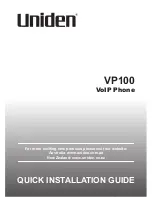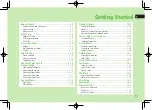
Copyright 2010-2017 Obihai Technology, Inc.
29
OBiTALK Portals
OBiTALK.com is a device management portal website to serve Obihai customers and service providers deploying OBi
devices. OBiTALK.com uses remote provisioning to manage OBi devices; it stores, or dynamically generates on demand,
a configuration file for each managed device which periodically checks in with the OBiTALK server for configuration
updates.
There are two levels of management portals at OBiTALK.com:
User
and
ITSP
.
User Portal
Users may add one or more OBi devices to their OBiTALK account to be managed. The portal has setup wizards that
help the user configure voice services on any of their devices. Users can also see the detailed status and current
parameter values of their devices and easily change settings on multiple devices from within the portal. The User Portal
has an upper limit of 20 devices per portal instance.
Device Management Platform (DMP) Portal
–
for ITSPs
Service providers and system Integrators can add devices to the OBiTALK portal and manage them in ways similar to
regular users. Zero Touch (ZT) devices, on the other hand, a
re added to the corresponding customer’s ITSP account
automatically, as soon as the earmarked units are manufactured at the factory. ZT device customers can monitor the
status of their units on the portal and check if (and when) new units have contacted the ZT server at OBiTALK.com and
are successfully customized.
In addition, service providers and system integrators using the OBiTALK DMP portal can configure their devices on
OBiTALK.com in batch mode by defining XML base profiles that may be applied to many units. When a base profile is
changed, all units using this base profile will be automatically updated with any changes that have been made.
Telephone-IVR-Based Local Configuration
The OBi1000 has a built in IVR for checking and setting a small but essential subset of configuration parameters.
Configuration via the IVR is a legacy configuration method inherited from older OBi products that do not have a display
(such as the OBi202 and OBi508). It is included here nevertheless for additional convenience and also so that customers
who are already familiar with using the OBi IVR can perform basic configuration tasks without learning new specifics
about the phone first.
The IVR is, in essence, an instance of an automated attendant (AA). The OBi offers two instances of AA; referred to as
AA1 (or just AA where the suffix 1 is implied) and AA2. The IVR for configuration purposes is AA2, which we will just
refer to as the IVR to avoid confusion with AA1, which is the AA used to handle phone calls. AA is covered as the subject
of a later section.
To invoke the IVR, the user picks the phone, dials * * * and follows the announced instructions. In order for the * * *
number to work, make sure the digit map pattern
***
is included in the
Phone Settings
::
DigitMap
parameter, and
the rule,
{***:aa2} is
included in the
Phone Settings
::
OutboundCallRoute
parameter. The standard (non-
customized) default values of these parameters are, respectively:
([1-9]x?*(Mpli)|[1-9]S9|[1-9][0-9]S9|***|**0|**8(Mbt)|
**1(Msp1)|**2(Msp2)|**3(Msp3)|**4(Msp4)|**9(Mpp)|(Mpli))
and
{([1-9]x?*(Mpli)):pp},{**0:aa},{***:aa2},{(<**1:>(Msp1)):sp1},
{(<**2:>(Msp2)):sp2},{(<**3:>(Msp3)):sp3},{(<**4:>(Msp4)):sp4},
{(<**8:>(Mbt)):bt},{(<**9:>(Mpp)):pp},{(Mpli):pli}
















































